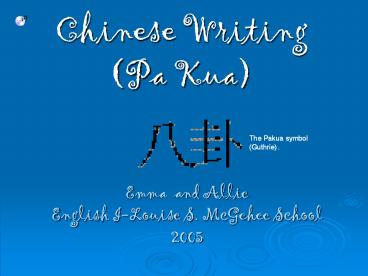Chinese Writing (Pa Kua) - PowerPoint PPT Presentation
1 / 11
Title:
Chinese Writing (Pa Kua)
Description:
To make Chinese calligraphy, one puts the symbols of the Pakua together to make ... Chinese symbol for Feng Shui ('Mondoalternativo'). Links to the Modern World ... – PowerPoint PPT presentation
Number of Views:199
Avg rating:3.0/5.0
Title: Chinese Writing (Pa Kua)
1
Chinese Writing (Pa Kua)
The Pakua symbol (Guthrie).
- Emma and Allie
- English I-Louise S. McGehee School
- 2005
2
Fu-Hsi The First of 3 Sovereigns
- The ancient symbols of Pakua were created by one
of the three sovereigns, named Fu-Hsi. - These three noble emperors were called the
San-Huang. - According to legend, Fu-Hsi was held in his
mothers womb for 12 years. - He was known as the Oxtamer for his ability to
teach men how to tame wild animals. (Hales)
Fu-Hsi (Nanian).
3
The Pakua
- Pakua is eight trigrams, or figures, that make up
the foundation for the Chinese writing. - It is also known as bagua, ba meaning eight,
and gua meaning figures or images. - The figures show fundamental ways that energy
moves.
4
The Pakua
- The Pakua trigrams are put together in an
octagonal shape to form the Chinese compass. - South is placed at the top and north is placed at
the bottom while all of the sub-directions are
placed accordingly around the octagon.
- Li, the symbol of the sun, wind, and wood, is
placed towards the south. - Kan, the symbol of the water, is placed towards
the north. - Tui and Chen, symbols of the lake and thunder,
are placed at west and east, respectively.
5
The Eight Trigrams
- Chien Heaven
- Sun sun, wind, or wood
- Kan water
- Ken mountain
- Kun earth
- Chen thunder
- Li fire
- Tui lake
The eight Pakua trigrams (I Ching).
6
Chinese Calligraphy
- To make Chinese calligraphy, one puts the symbols
of the Pakua together to make hexagrams or larger
figures that mean other things.
?This figure means Opposition, and it is Pakua
symbols Li (fire) and Tui (lake) together. Li
is on top of Tui (I Ching).
?This figure means Radical Change. It is also
Li and Tui together, but now Tui is on top of Li
(I Ching).
7
Ancient Use of the Pakua
- The Pakua is a main reference in the making of
Chinese myths. - The Pakua symbol is one of the most important
symbols of protection against poison arrows or
other harmful structures (I Ching). - The symbol of Early Heaven is also credited with
the power to ward off evil spirits.
The Early Heaven symbol (Light Easy).
8
Feng Shui and Pakua
- In Feng Shui, the Pakua symbols determined where
objects were to be placed in order to create
better living for the owner and family of the
home. - The octagonal points of the Pakua are used to
interpret good and bad Feng Shui.
Chinese symbol for Feng Shui (Mondoalternativo
).
9
Links to the Modern World
- The Pakua is still the basis of the Chinese
written language today. - The hexagrams that the Pakua makes have all been
grouped together to form a group of characters
called I Ching. - The Pakua symbols are still a large part of the
Feng Shui method today.
(I Ching).
10
I Ching
- The I Ching is a book of 64 hexagrams that are
used to determine someones fate. - A person must roll three coins, heads counting
for 3 and tails counting for 2. - Whatever the number comes out, this is the type
of line that starts out your hexagram. - Roll the coins 5 more times to complete the
hexagram.
11
Works Cited
- Casting a Hexagram. I Ching Resources. 11
January 2005. lthttp//www.onlineclarity.co.uk/I_
Ching_resources/hexagrams.htmlgt - Feng Shui. Light Easy. 2004. 7 January 2005.
lthttp//www.lightradio.com/my/03/leisure/fengshu
i/Default.asp3Fwhichpage 3D6426pagesize3D1h1
95w200sz12tbnidXJ2M9PVvLwoJtbn h96tbnw9
8start11prev/images3Fq3Dearly2Bheaven26hl
3D en26lr3D26safe3Doffgt. - Feng Shui. Mondoalternativo. 2004. 6 January
2005. - lthttp//www.mondoalternativo.com/shopsite_tx/sto
re/html/feng_shui.htmgt. - Guthrie, William B. Pakua. MMV Encyclopedia
Mythica. 26 March 1997. 4 January 2005.
lthttp//www.pantheon.org/articles/p/pakua.htmlgt. - Hales, Stephen. Rex in the Classroom 2005.
Handout. 2005. - I Ching. Asia Rooms. 1996. 5 January 2005.
lthttp//www.asiarooms.com/china- travel-guide/cul
ture/Myths/paqua.htmlgt. - Nanian, Richard A. Advanced Composition for the
Humanities. George Mason University. 5
January 2005. lthttp//www.classweb.gmu.edu/rnan
ian/302main.htmlgt. - The Trigrams. I Ching Resources. 4 January
2005. lthttp//www.onlineclarity.co.uk/I_Ching_re
sources/trigrams.htmlgt.































